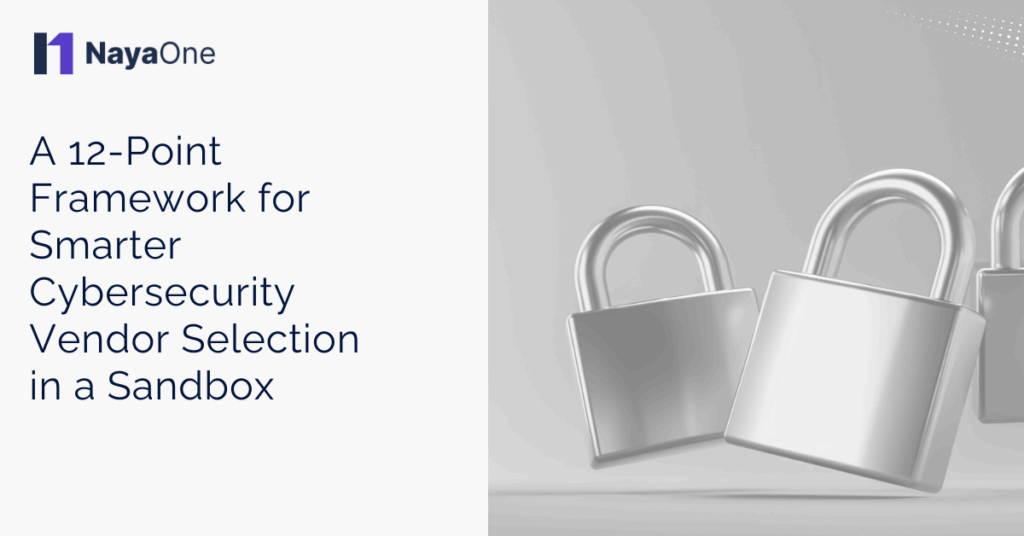Cybersecurity isn’t just a technical issue - it’s a boardroom priority. Choosing the wrong vendor can lead to regulatory fines, reputational damage, operational downtime, and costly rework. Industry stats paint a stark picture: by 2027, 60% of security incidents will stem from integration failures or capability mismatches, not product flaws (Gartner, 2024). Meanwhile, 37% of security tool deployment delays are due to integration complexity (Gartner, 2024). The stakes are high, and traditional evaluation methods like RFP scoring or vendor demos often fall short, delivering optimistic promises that don’t hold up in the real world.
Enter the sandbox - a game-changer for vendor evaluation. A production-representative sandbox lets you test multiple vendors side by side under realistic threat, traffic, and integration conditions, giving you hard evidence before signing a contract. Enterprises using structured, scenario-based evaluations report a 45% lower vendor failure rate within 18 months (NayaOne, 2024).
We’ve distilled best practices from leading enterprises into a 12-point framework for sandbox-led cybersecurity vendor evaluation, tailored for industries like financial services, insurance, and regulators. Here’s how to make smarter, evidence-based decisions.
1. Align Threat Scenarios to Your Risk Profile
Your tests must mirror the threats your organisation faces. For example:
- Financial Services: Ransomware, account takeovers, payment fraud.
- Insurance: Data breaches of sensitive customer data, insider credential abuse.
- Regulators: Unauthorised access to supervisory data, compliance reporting manipulation.
This keeps evaluation data relevant to your operational teams and board, ensuring the vendor addresses your real-world risks.
2. Set Clear, Measurable Success Metrics
Before testing, define quantitative benchmarks:
- Detection rates and false positive thresholds
- Mean Time to Detect (MTTD)
- Mean Time to Respond (MTTR)
- Recovery Time Objectives (RTO)
Why? Enterprises with predefined metrics are three times more likely to see measurable ROI (McKinsey, 2024).
3. Test Against Evasive and AI-Driven Threats
Don’t just rely on known attack signatures - they inflate performance results. Include:
- Obfuscated payloads
- Polymorphic malware
- Zero-day exploit simulations
- AI-generated attacks (e.g., deepfake phishing, automated exploit mutation)
This tests a vendor’s resilience against the unknown, especially critical as AI-driven attacks are set to make up 25% of incidents by 2026 (Forrester, 2025).
4. Mimic Real-World Traffic and Environments
Your sandbox should replicate:
- Peak transaction volumes
- Endpoint diversity
- Latency patterns
- Multi-cloud, hybrid, or edge environments (e.g., AWS, Azure, IoT networks)
Underperformance under realistic load is a top reason for vendor replacement within 18 months (Gartner, 2024). Plus, 80% of enterprises now operate in multi-cloud setups (IDC, 2025).
5. Gauge Integration Complexity and Ecosystem Fit
Track:
- Technical configuration effort.
- API readiness and interoperability with tools like Splunk or CrowdStrike.
- Dependencies on systems or teams.
- Compatibility with Zero Trust frameworks (continuous authentication, micro-segmentation).
Integration issues cause over a third of deployment delays (Gartner, 2024), and 70% of enterprises rely on multiple tools requiring seamless orchestration (Gartner, 2025).
6. Assess Analyst Experience and Workflow Fit
Measure:
- Time to triage alerts.
- Steps to investigate incidents.
- Automation alignment with existing playbooks.
- Quality of vendor-provided training and documentation.
Poor adoption can sink even the best tools, with 25% of failures tied to inadequate training (ESG, 2024).
7. Test Incident Response and Recovery
Evaluate:
- Automated containment.
- Multi-step response orchestration.
- Depth of forensic reporting.
Vendors with strong automation can slash containment times by 30–50% in sandbox testing (NayaOne, 2024).
8. Ensure Compliance and Data Sovereignty
Verify audit-ready reports for frameworks like ISO 27001, NIST CSF, PCI DSS, GDPR, and region-specific rules (e.g., China’s PIPL, US CMMC). Check data residency options for geographic compliance. Non-compliance can lead to fines averaging £8 million per incident (Deloitte, 2025).
9. Check Scalability and Degradation
Ramp up load to spot:
- Performance cliffs
- Accuracy drop-off points
- Latency spikes
This ensures the solution scales with your business without losing effectiveness.
10. Calculate Total Cost of Ownership (TCO) and Lock-In Risks
Consider:
- Licence fees
- Infrastructure costs
- Integration and training
- Ongoing operational overhead
- Data portability and exit strategies to avoid lock-in
Hidden costs can inflate nominal licence fees by 35–50% (McKinsey, 2024), and 40% of enterprises struggle to switch vendors due to proprietary formats (Forrester, 2024).
11. Vet Vendor Stability
Assess:
- Financial health (funding, profitability).
- Customer retention and churn rates.
- Frequency and quality of updates/support.
With 20% of cybersecurity startups failing within five years due to funding issues (CB Insights, 2025), stability is non-negotiable.
12. Confirm Zero Trust and AI Integration
Test:
- Support for Zero Trust (continuous authentication, granular access).
- AI-driven detection and response.
- Integration with IAM systems and threat intelligence feeds.
By 2027, 60% of enterprises will adopt Zero Trust (Gartner, 2025), making compatibility essential.
Mapping Vendors: Efficacy vs. Complexity
Sandbox testing lets you plot vendors on two axes:
- Efficacy: Detection, response, and recovery performance.
- Integration Complexity: Effort to embed the solution.
Aim for the sweet spot: High Efficacy, Low Complexity for rapid deployment and robust protection. Steer clear of Low Efficacy, High Complexity - it’s a recipe for high risk and low ROI.
Why It Matters
Sandbox-led evaluation replaces vendor hype with hard data. Running parallel tests speeds up decision-making, while 6–8 weeks of validation can save months of rework and millions in breach-related costs.
How NayaOne Makes It Happen
NayaOne’s air-gapped sandbox infrastructure brings this framework to life:
- Parallel Vendor Testing: Identical, production-like conditions for fair comparisons.
- Synthetic Data Libraries: Safe, representative datasets without exposing PII.
- Integration Validation: Pre-procurement checks for workflows, cloud, and Zero Trust compatibility.
The results? Enterprises using NayaOne cut vendor shortlisting cycles by 60%, reduce post-onboarding replacement rates by 40%, and see measurable security improvements within 6–12 months.
Take Action





